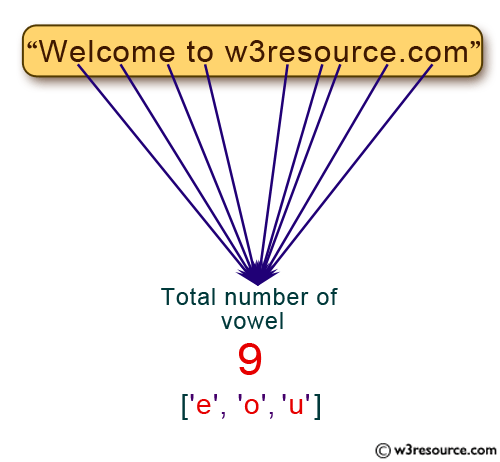

The above program only uses dictionary comprehension but in this program, we have nested a list comprehension inside a dictionary comprehension to count the vowels present in a string. Using a list and a dictionary Comprehension In each iteration, we check if the character is in the dictionary keys ( True if it is a vowel) and increment the value by 1 if true. Basically, this method returns a lowercased version of the string. Here, we use the casefold() method to ignore the cases. # make a dictionary with each vowel a key and value 0Įnter any string: count vowels in a string # make it suitable for caseless comparisions # Python program to count the number of each vowel This is a better and efficient way to check the number of each vowel present in a string. In this method, we form a dictionary comprehension with the vowels and increment them when a vowel is encountered. This python program also performs the same task but in a different way.

No of vowels = 5 Python Program to Count the Number of Each Vowel # Python program to count vowels in a string using while loop In the above program, we will count vowels in a string using the for loop but in this program, count vowels in a string using the while loop. Num_vowels = ĬheckVowels(string) Count Vowels in a String Python using While Loop We can also write a program in a simple way to count vowels in a string. Print('No of vowels =',countVowels(string)) # Python program to count vowels in a string Finally, call the function and the result will be displayed on the screen.

Then, we will take a string while declaring the variables. We will take a user-defined function to count the number of vowels present in a string. This python program using the for loop to count vowels in a string. The alphabets ‘A’, ‘E’, ‘I’, ‘O’, ‘U’ (in uppercase) and ‘a’, ‘e’, ‘i’, ‘o’, ‘u’ are vowels, and remaining alphabets are called consonants. Now in this post, we will count vowels in a string in python using various methods. While we're celebrating Cybersecurity Month all 31 days this October, this week (Oct 16 - 22, 2022) is known as Cybersecurity Career Awareness Week and focuses on raising awareness around cybersecurity job training and opportunities.Previously we have to check a character is a vowel or consonant and check if a string starts with the vowel.
#COUNT RUN WITH 5 VOWELS WINDOWS#
#COUNT RUN WITH 5 VOWELS SKIN#
Snap! - Cybersecurity AI, E-waste, Slinkys in Space, and Skin Cancer Vaccines Spiceworks Originals.Please upvote it if you got the desired answer. Temp_counter=vector_append(temp_counter,counter)

Temp_alpha=vector_append(temp_alpha,str_vec) If(counter>1 and check_for_repeats=0) begin Let string(1) temp_alpha=allocate_with_defaults() Ĭounter=length_of(vector_search_all(str_vec,str_vec)) Let string(1) temp_counter=allocate_with_defaults() Let string(1) str_vec=(string(1))reinterpret(string_filter("DICTIONARY","A|E|I|O|U|a|e|i|o|u"))
#COUNT RUN WITH 5 VOWELS FREE#
You can free to leverage the graph level parameters. This is a bit complex but can be achieved by the collective use of string_filter and vector_search_all functions.


 0 kommentar(er)
0 kommentar(er)
